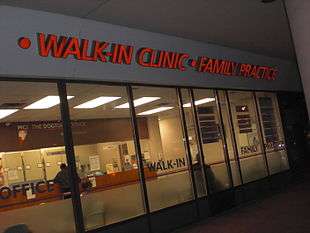Walk-in clinic

A walk-in clinic describes a very broad category of medical facilities only loosely defined as those that accept patients on a walk-in basis and with no appointment required. A number of healthcare service providers fall under the walk-in clinic umbrella including urgent care centers, retail clinics and even many free clinics or community health clinics. Walk-in clinics offer the advantages of being accessible and often inexpensive.[1] However amongst the negative aspects are that walk-in clinics provide poor quality healthcare as opposed to professional healthcare such as regular doctors and hospitals.[2] Other disadvantages may include the urgency to make the patient's visit as quick as possible in order to reduce the long waiting list of walk-ins at the clinic, which may fail to fulfill the purpose of the visit.[3]
It is estimated that there are nearly 11,000 walk-in clinics in America, although it is impossible to calculate an exact number given the variable and ill-defined nature of the category. Urgent care centers make up the largest percentage of walk-in clinics in America with an estimated 9,000 locations nationwide. In fact, consumers often erroneously refer to all walk-in clinics as urgent care centers, and vice versa. Retail clinics are the next most prevalent in the industry with 1,443 locations as of July 1, 2013.[4]
Services
Urgent care clinics are usually led by physicians. The much smaller category of retail clinics, which are stand-alone clinics located inside large retail stores or shopping malls, tend to be headed by nurse practitioners. The significantly higher price for an urgent care visit compared to a retail clinic visit is largely attributed to this difference in staffing.[2]
All types of walk-in clinics provide basic medical services, such as routine vaccinations, evaluation of cold and flu symptoms, and treatment for less severe physical injuries. Urgent care centers normally provide more services, such as X-ray testing for suspected pneumonia or broken bones.[2]
Access to the patient's regular medical records depends on the agreements that the clinic has with other organizations. For example, a walk-in clinic that is part of or affiliated with a hospital or larger clinic may have full access to all the medical records belonging to the larger institution, while an independent walk-in clinic may not have access any patient records except those related to previous visits to that walk-in clinic. This lack of access can prevent healthcare providers from recognizing chronic problems.[5]
Major companies

According to Merchant Medicine's U.S. Walk-in Clinic Market Report for July 2013, the following are the top twenty walk-in clinic brands:
| Company Brand | # of Clinics |
|---|---|
| MinuteClinic (CVS) | 665 |
| Healthcare Clinic at Walgreens | 371 |
| Concentra | 309 |
| US Healthworks | 145 |
| AFC Doctors Express | 140 |
| MedExpress | 112 |
| The Little Clinic | 93 |
| NextCare | 87 |
| Target Clinic | 54 |
| FastMed | 53 |
| Doctors Care | 52 |
| Patient First | 46 |
| CareSpot | 45 |
| RediClinic | 30 |
| Physicians Immediate Care | 29 |
| Hometown | 27 |
| FastCare | 25 |
| Baptist Express Care at Walmart | 18 |
| WellNow | 17 |
| DR Walk-In Medical Clinics | 13 |
Controversies
The existence of walk-in clinics has been controversial. Doctors acknowledge that Minute Clinics and other retail-based clinics are convenient. They admit that the clinics are cutting into their own income. However, doctors say they are trying to build a relationship with their patients, meet them regularly, and follow up on problems. The clinics interfere with that relationship and fragment health care. Furthermore, said pediatrician Claire McCarthy, "Sometimes a minor thing isn't so minor." The clinics don't have the patient's medical record, and don't know the history. A swollen knee, if it is part of a pattern, might be a sign of arthritis.[5] The American Academy of Pediatrics has recommended that parents do not use retail-based clinics for their children.[6]
References
- ↑ "Urgent Care at a Walk-in Clinic". Doctors Express. Retrieved 16 June 2014.
- 1 2 3 "10 things walk-in clinics won't tell you". MarketWatch. Retrieved 2 November 2012.
- ↑ "Walk-in clinic: an experience to be dreaded". Toronto Sun. Retrieved 22 March 2009.
- ↑ The ConvUrgentCare Report: U.S. Walk-in Clinic Market Report, Volume 6, No. 7. Merchant Medicine, LLC. July 1, 2013.
- 1 2 Why doctors worry about Minute Clinics--and what they should learn from them Claire McCarthy , Boston Globe, February 24, 2014
- ↑ Laughlin JJ, Simon GR, Baker C, Barden GA, Brown OW, Hardin A, Lessin HR, Meade K, Moore S, Rodgers CT (March 1, 2014). "From the American Academy of Pediatrics. Policy Statement. AAP Principles Concerning Retail-Based Clinics.". Pediatrics. 133 (3): e794–e797. PMID 24567015. doi:10.1542/peds.2013-4080.